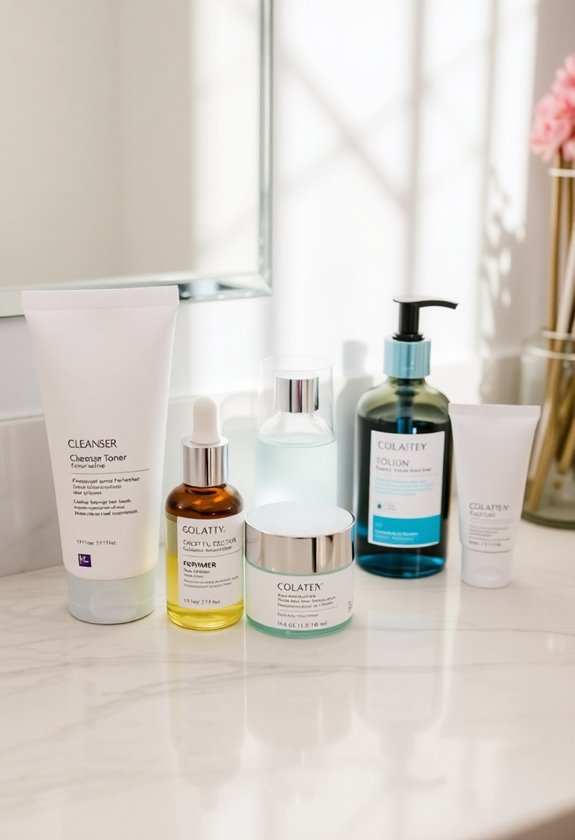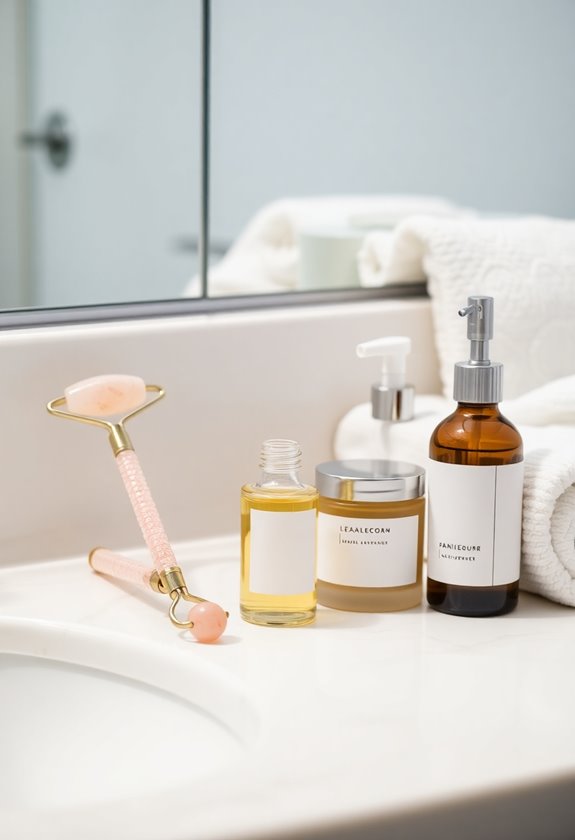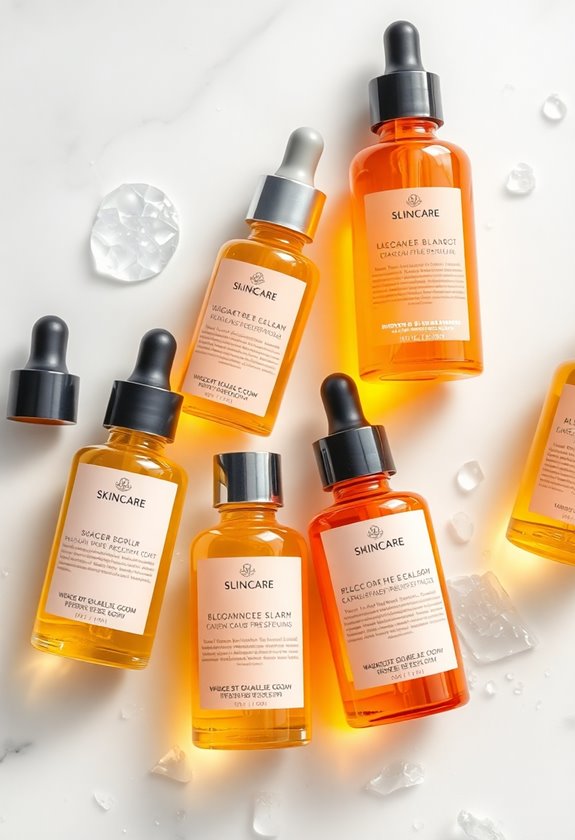Start your morning acne-fighting routine by cleansing with a gel-based or foaming cleanser that contains salicylic acid to remove excess oil and debris. Next, apply an alcohol-free toner with witch hazel to balance your skin's pH and minimize pores. Follow with a lightweight, non-comedogenic moisturizer containing niacinamide to control oil production and reduce inflammation. For targeted treatment, use a spot treatment or serum with benzoyl peroxide or salicylic acid on active breakouts. Finally, protect your skin with a broad-spectrum SPF 50+ sunscreen formulated for acne-prone skin. Understanding these essential steps will help you discover additional strategies for maintaining clear, healthy skin.
Highlights
- Start with a gentle gel cleanser containing salicylic acid to remove overnight oil buildup and unclog pores.
- Apply an alcohol-free toner with witch hazel to balance skin pH and minimize inflammation.
- Layer on niacinamide serum to control oil production and reduce redness associated with acne.
- Use a lightweight, non-comedogenic moisturizer to hydrate skin without clogging pores.
- Finish with broad-spectrum SPF 50+ sunscreen to protect against UV damage and prevent acne scarring.
Setting Up Your Morning Routine

Starting a morning skincare routine for acne requires careful planning and the right combination of products. Regular follow-ups with a dermatologist can help ensure your treatment plan is effective. You'll need to select items that match your specific skin type, whether it's oily, dry, or combination, to guarantee the best results.
Here's how to structure your basic routine:
- Begin with a cleanser that fits your skin type – gel-based for oily skin or cream-based for dry skin
- Apply your chosen serums, focusing on ingredients like salicylic acid or niacinamide
- Use a suitable moisturizer that won't clog your pores
- Finish with a non-comedogenic SPF 50+ sunscreen
Remember to maintain consistency with your routine, as this is vital for managing acne effectively. You'll want to adjust your product selection seasonally to address changing skin needs while keeping the same structured approach. Don't forget to pay special attention to the delicate eye area, where using targeted eye creams can help maintain skin health while treating acne.
Deep Cleansing for Clear Skin
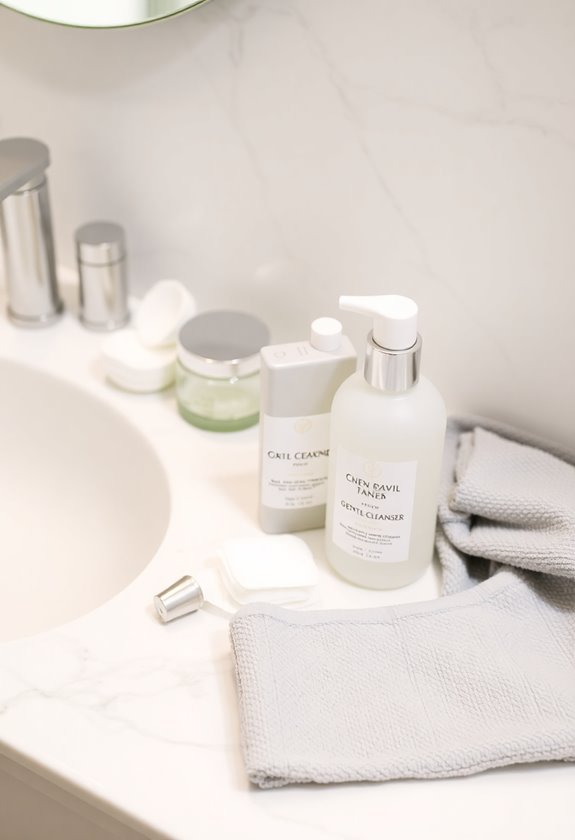
Deep cleansing forms the foundation of any effective acne-fighting routine. You'll need to focus on thoroughly removing excess oil, dead skin cells, and impurities that can clog your pores and lead to breakouts. A proper deep cleansing routine combines daily care with periodic intensive treatments to maintain clear, healthy skin. Professional treatments can provide enhanced extraction methods for stubborn blackheads and whiteheads.
- Start with a gentle micellar water cleanser followed by a foaming acne face wash
- Use products containing salicylic acid to prevent clogged pores
- Apply a purifying mask with charcoal or clay 1-2 times weekly
- Incorporate gentle exfoliation using BHA or AHA products
- Follow with a non-comedogenic moisturizer to maintain skin balance
Remember to customize your deep cleansing routine based on your skin type, and don't skip your twice-daily cleansing schedule, as consistency is key for managing acne-prone skin.
Balancing With Toning Steps
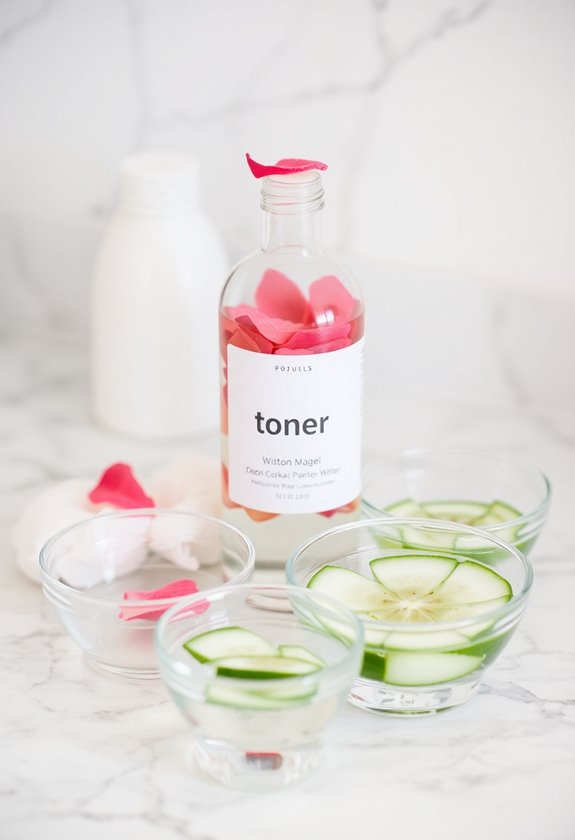
After cleansing your skin thoroughly, the next meaningful step in your morning routine involves toning. You'll want to select a toner that's specifically formulated for acne-prone skin, ideally containing salicylic acid to help dissolve excess oil and dead skin cells. Maintaining consistency with your toning routine is essential for achieving the best results in managing breakouts. For the best results, look for toners with soothing ingredients like witch hazel or rosewater, which can calm your skin while balancing its pH levels. Your toner should be labeled "non-comedogenic" to guarantee it won't clog your pores. Apply the toner right after cleansing and before any serums or treatments, as this helps prepare your skin for better product absorption. If you're dealing with large pores or excessive oil, consider using a pore-minimizing toner that'll help refine your skin's surface while maintaining its natural balance.
Hydration and Treatment Methods
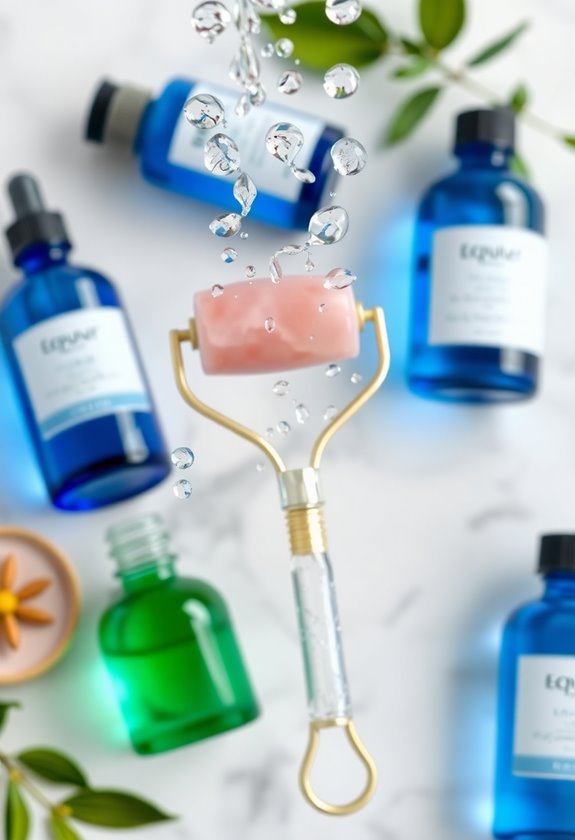
Proper hydration and targeted treatments form the cornerstone of an effective morning skincare routine for acne-prone skin. You'll want to focus on lightweight, water-based products that won't clog your pores while delivering essential moisture. Start with a hyaluronic acid serum to lock in hydration, followed by treatment products containing active ingredients that target your specific concerns. A proper balance of water and oil is crucial for maintaining healthy skin and preventing breakouts.
- Apply niacinamide to control excess oil production and reduce redness
- Use salicylic acid for gentle exfoliation and pore cleansing
- Incorporate succinic acid to combat inflammation and prevent breakouts
- Choose gel moisturizers over heavy creams for non-greasy hydration
- Layer your products from thinnest to thickest consistency for ideal absorption
Remember to seal everything with a suitable lightweight moisturizer, which will help maintain your skin's barrier while keeping excess oil production in check.
Sun Protection and Prevention
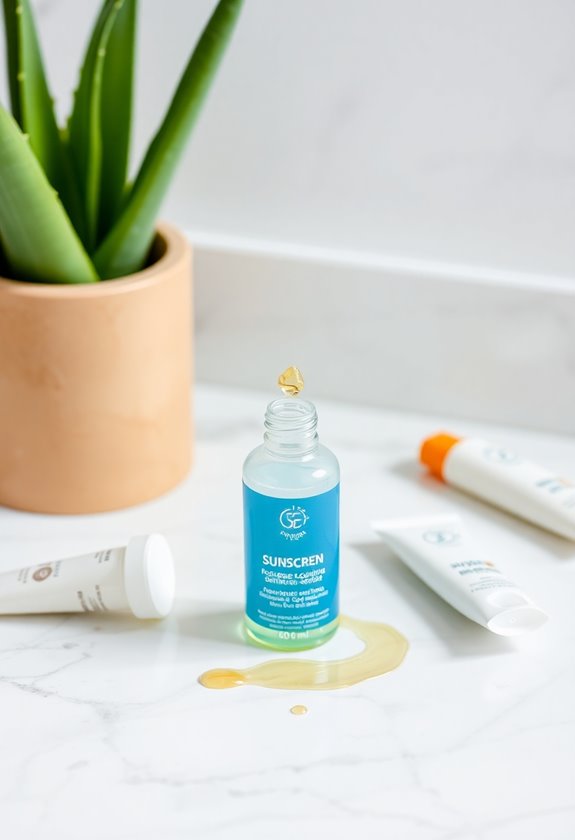
The unrelenting sun poses a significant threat to acne-prone skin, making sunscreen your most essential defense against UV damage. You'll need to choose a broad-spectrum SPF 50+ that's specifically formulated for acne-prone skin, such as EGO Sunsense Daily Face or Neutrogena Hydro Boost Water Gel Lotion. Mineral sunscreens tend to be gentler on sensitive skin.
For peak protection, follow these key practices:
- Apply your sunscreen as the final step in your morning routine, after moisturizer
- Confirm you're using a non-comedogenic, fragrance-free formula to prevent clogged pores
- Reapply every two hours, especially during summer or after sweating
- Don't skip application on cloudy days
Regular sunscreen use won't just protect your skin – it'll also help prevent post-inflammatory hyperpigmentation and reduce the risk of acne scarring.
Frequently Asked Questions
How Long Should I Wait Between Applying Each Skincare Product?
You don't need to wait between cleansing and toning, but give your skin 1-2 minutes between each subsequent product to guarantee proper absorption. While serums can take up to 30 minutes to fully absorb, you can continue your routine after 1-2 minutes. Apply your moisturizer immediately after serums, but if it's oil-based, wait 2 minutes before adding sunscreen.
Can I Skip Moisturizer if My Skin Feels Oily in the Morning?
You shouldn't skip moisturizer, even when your skin feels oily. Skipping moisturizer can actually trigger your skin to produce more oil to compensate for the lack of hydration. Instead, opt for a lightweight, oil-free moisturizer that's specifically formulated for oily skin types. When your skin is properly hydrated, it'll naturally balance oil production and help maintain a healthier complexion.
Should I Use Different Products on Different Areas of My Face?
Have you noticed some areas of your face feeling oily while others are dry? That's completely normal! You should definitely use different products on different areas of your face, as each zone has unique needs. For example, use oil-controlling products with salicylic acid on your T-zone if it's oily, while applying hydrating products with hyaluronic acid to drier areas like your cheeks. This targeted approach will help maintain your skin's balance effectively.
Is It Necessary to Wash My Hands Between Applying Each Product?
While you don't need to wash your hands between each product, it's crucial to avoid touching other surfaces during your routine. If you accidentally touch your phone, doorknob, or other objects, you'll need to rewash your hands. Using tools like spatulas or pumps can help maintain
Should I Adjust My Skincare Routine During Hormonal Changes or Menstruation?
Just as a garden needs different care through changing seasons, your skin requires adjusted attention during hormonal shifts. You'll want to adapt your skincare routine to match your menstrual cycle's phases:
- Use gentle, moisturizing products during menstruation
- Add salicylic acid treatments pre-period for congestion
- Incorporate niacinamide serums during ovulation
- Focus on calming ingredients like aloe vera when sensitivity peaks
- Choose lightweight formulas when oil production increases

